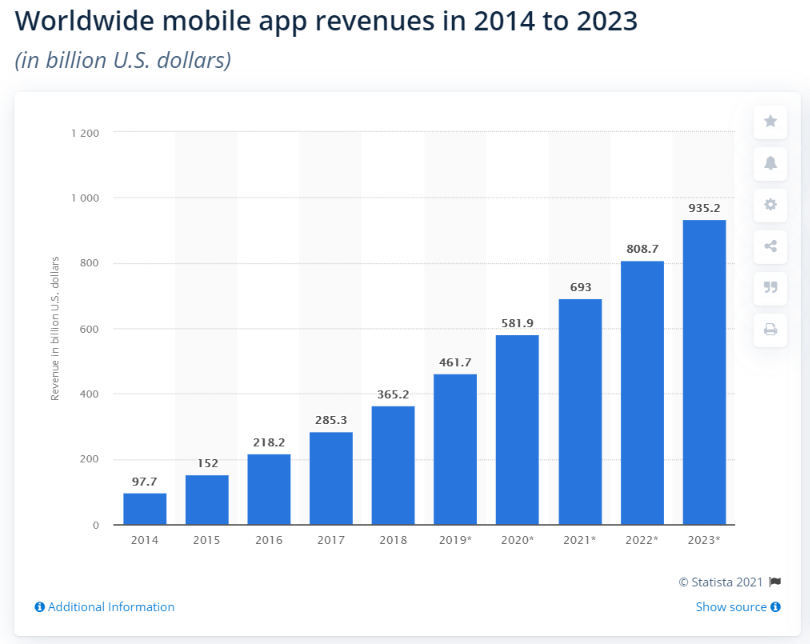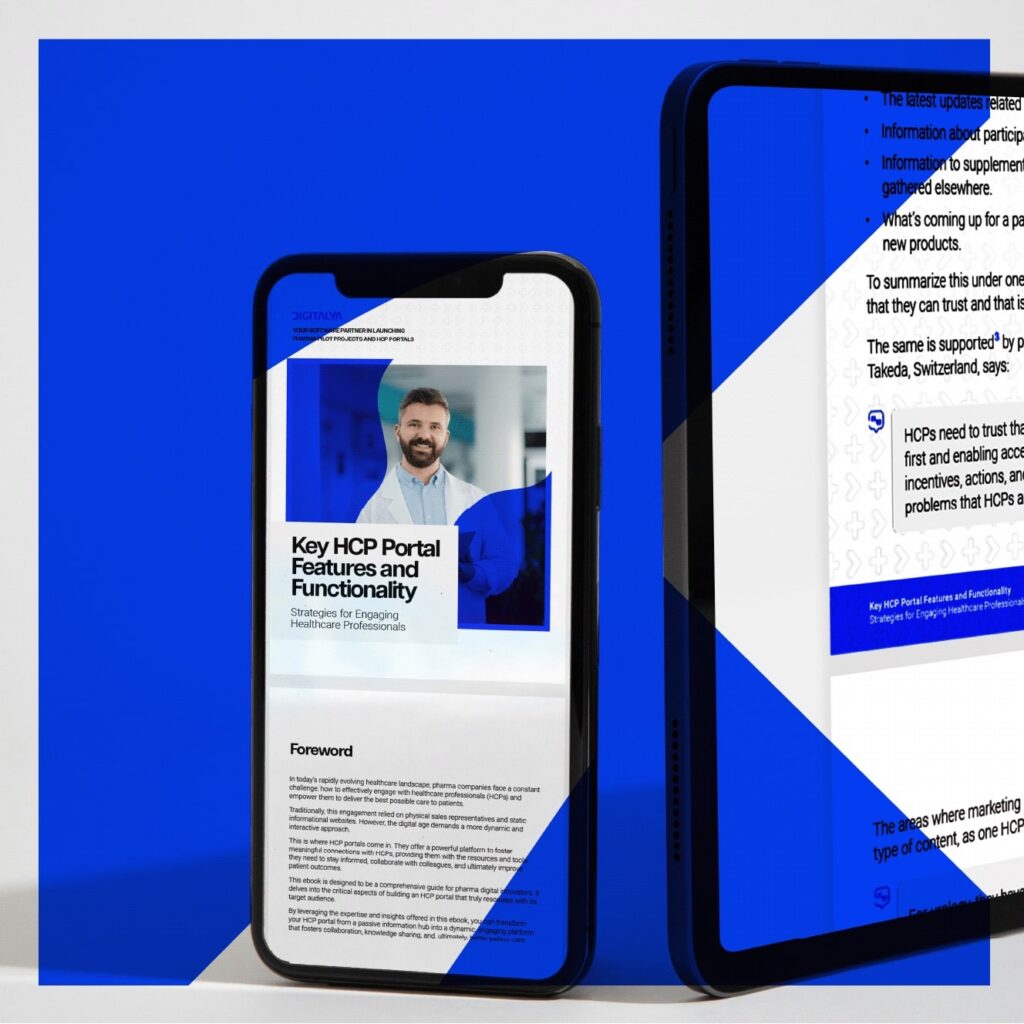The reasons behind building an app are diverse: from optimizing a specific process to improving customer engagement, reducing marketing costs, making life easier for a certain niche, and others. But, even though each entrepreneur has a different reason for doing it, in the end, the app it’s a source of business growth, and of course, of new income.
There are different ways in which an app can generate money – in-app advertising, premium features, affiliate marketing, in-app purchases, subscriptions, etc. We’re going to tackle some of them in this article, but our focus will be on breaking down how much money apps make per download. So let’s roll.
1. Are apps profitable?
According to Statista, in 2020, people spent an amount of 143 billion U.S. dollars only on mobile apps, compared to 120 billion U.S. dollars in 2019 and 101 billion U.S. dollars in 2018. So if we look at this number, we can definitely see an increase. And why wouldn’t it be? Apps make our life easier. They help us remember when to water our plants, they give us our daily updates, and they make it easier for us to do our shopping. From a music app to a streaming app, they keep us company daily.

So, is there any profit for app owners from 143 billion U.S. dollars? You bet there is. But while some acquire a great deal of money, others revolve around less than $30,000 a year before taxes.
And this takes us to the following question: what makes an app successful in having a growing user base? Of course, a lot of things, and among them, we can name the app quality, the sales & marketing effort, and the community management. In a previous article, we have more details about the subject of how to create an app and make money. If you’re curious, you can read more there.
2. How do app owners make money?
Let’s further discuss how do app owners make money and how much you can earn with an app. As you might know, some of the most profitable apps in 2021 are Netflix, Spotify, Tinder, TikTok, Facebook, and YouTube, and no wonder why. They are enjoyable, have a good user experience, and kind of get you addicted. And even though they have different monetizing strategies, they are leading the app market.
App owners are making money by applying some smart monetizing strategies based on their business model. Among the apps monetization strategies, we can name:
The free and paid app versions model or the freemium app model
The freemium models are the most popular monetization strategies. Users can download the app for free, but they have limited access to certain features. While using an app that is working on this kind of monetization method, users can find both free and paid features. By building the app in this manner, you encourage the free users to upgrade to the paid version in order to enjoy the full experience.
With this business model, you can satisfy paying and no paying users by providing different content. To the first ones, you provide basic functionality, while to the others, you give premium functionality. Moreover, in order to keep the no-paying users engaged and maybe motivate them to go to the next step, you can keep them informed regarding app updates and new features.
The free app with in-app purchases model
This is maybe the second most popular strategy among the app monetization models, and you can usually find it in dating apps and gaming apps. For example, in a gaming app, most users can use the app for free, but if they want some extra lives or to skip some levels, they would need to pay.
There is also another strategy where users receive access to premium features in a gaming app without paying if they play long enough. The aim is to keep the user more in the application. In other cases, this strategy is not applicable, and users can only benefit from them by paying. This monetization strategy is flexible, and you can play with it as you want as long as you keep an eye on the revenue too.

The free app with a subscription model
With this monetization strategy, you make your app free to download but give limited access to the content. Calm, the meditation app, uses this strategy, for example. Users can find some meditation sessions for free, but they will need to subscribe if they want more. This monetization method is mostly found in service-oriented apps, where you get new content regularly. Duolingo it’s another provider that works on this system.
The paid app model
The paid app model is less common these days than the first one, and usually, you can find it in sectors like photo & video, productivity, and utilities. By using this strategy, you get paid each time your app is downloaded from the store individually or as part of the App Bundle – a service iOS offers where customers can buy up to ten apps or games at once.
The free model with ads or in-app advertising
The mobile applications’ in-app advertising model is quite common these days since it’s effective for publishers because it’s driving media consumption and for business owners because it brings revenue. The model consists of giving all the features for free to the users but showing them ads from time to time.
The in-app advertising model is a vital marketing channel for companies since it brings user targeting and data tracking to a whole new level, so if you don’t want to think of a more complicated business model for your app, this is the one for you.
If you opt for this monetization strategy, then you should know that there are different types of ad formats, and these can be: banner ad, video ad, interstitial ad, native ad, or text ad. Of course, the one that grabs all your user’s attention is the interstitial ad, which basically occupies the whole smartphone screen, while the one that gets the least it’s the text ad.
You can benefit from app advertisements also by promoting your product in other apps from the store.
3. How much money do apps make per download?
As you know by now, there are different monetization strategies, so you can find out how much money do apps make per download by checking their business model. Free apps don’t get any money per download, while paid apps earn for each download, and subscription-based apps earn for each subscription bought.
You can calculate how much money apps make per download by checking their price in the App Store or Google Play. There are apps for which you pay one time only, while for others, you can pay for a certain amount of time, like one year.
While this is an interesting metric to follow, some are even more important, such as the development costs of building the app, what revenue model they use, and what profit they make per year. The money an app makes per download doesn’t really show if their business is healthy and profitable.

4. What kind of apps are in demand?
A factor that influences how much money do apps make per download is consumer trends because the more there is demand for a certain app type, the more you can increase the price. Of course, people’s needs change from year to year as technology advances, but you can definitely do some market research to better understand your niche and their habits.
If in 2020, the mobile app trends revolved around on-demand apps, entertainment apps, and news & information apps. The trending mobile apps are a bit different. On top of the market are goods exchange apps, media files sharing apps, community support apps, augmented reality apps, and fitness apps. It is quite visible that the pandemic affected human needs only by looking at how the requirements have changed.
In the future, the market demands might be on a different app category; there might be an increase in demand for healthcare apps, mobile gaming apps, social networking apps, or real estate apps. Before you start to build and launch an app, make sure you check the trends.
5. How do famous apps earn money?
In order to build a successful app and earn money, there are some things to take into consideration, like doing a competitor analysis, making sure that the app design is fabulous and users are having a great user experience, and marketing the product to the right targeted audience, choosing the right mobile application development company to build your mobile app, having a clear revenue generation strategy, and of course, learning from the best. So, let’s see how famous apps earn money.
How does Instagram make money?
Instagram has an in-app advertising model. Users are getting targeted with ads in the news feed and stories. You can identify which one is user-generated content and which one is an ad by the “sponsored” tag. Some users, though, wish that Instagram would have a subscription-based plan, so they could get rid of ads.
How does WhatsApp make money?
WhatsApp is earning money from two revenue streams. The first one is the Click to WhatsApp ads, and the second is the Business API. Currently, WhatsApp is making money through ads that redirect users from Facebook to WhatsApp and from registered businesses that get charged for slow replies. Companies had up to 24 hours to respond to messages from users. If they don’t, they are charged a certain fee per message.

How does YouTube make money?
As you might know, YouTube’s main source of revenue consists of advertising, and they also have a premium subscription where you can get rid of ads and have access to YT music.
How does Netflix make money?
Netflix has a huge amount of subscribers paying from $8.99/month to $15.99/month, and as you might have understood, they work on the subscription-based revenue model.
6. Conclusion
Netflix has a huge amount of subscribers paying from $8.99/month to $15.99/month, and as you might have understood, they work on the subscription-based revenue model.








